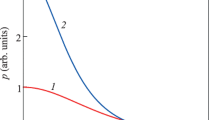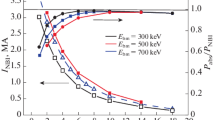Abstract
Disruption damage conditions for future large tokamaks like ITER are nearly impossible to simulate on current tokamaks. The electrothermal plasma source SIRENS has been designed, constructed, and operated to produce high density (> 1025/m3), low temperature (1–3 eV) plasma formed by the ablation of the insulator with currents of up to 100 kA (100 μs pulse length) and energies up to 15 kJ. The source heat fluence (variable from 0.2 to 7 MJ/m2) is adequate for simulation of the thermal quench phase of plasma disruption in future fusion tokamaks. Different materials have been exposed to the high heat flux in SIRENS, where comparative erosion behavior was obtained. Vapor shield phenomena has been characterized for different materials, and the energy transmission factor through the shielding layer is obtained. The device is also equipped with a magnet capable of producing a parallel magnetic field (up to 16 T) over a 8 msec pulse length. The magnetic field is produced to decrease the turbulent energy transport through the vapor shield, which provides further reduction of surface erosion (magnetic vapor shield effect).
Similar content being viewed by others
References
A. Sestero (1977). Protection of walls from hard disruption in large tokamaks.Nucl. Fusion 17, 115.
A. Hassanein (1991). Erosion and redeposition of divertor and wall materials during abnormal events.Fusion Technol. 19, 1789.
J. Gilligan and D. Hahn (1987). The magnetic vapor shield (MVS) mechanism for protection of high-heat flux components in highfield tokamaks.J. Nucl. Mater. 145-147, 391.
M. Bourham, O. Hankins, O. Auciello, J. Stock, B. Wehring, R. Mohanti, and J. Gilligan (1989). Vapor shielding and erosion of surfaces exposed to high heat load in an electrothermal accelerator.IEEE Trans. Plasma Sci. 17, 386.
M. Bourham, J. Gilligan, O. Hankins, W. Eddy, and J. Hurley (1992). Electrothermal Plasma Source as a High Heat Flux Simulator for Plasma-Facing Components and Launch Technology Studies. 9th International Conference on High Power Particle Beams, Washington, D.C., May 25–29.
J. Gilligan and R. Mohanti (1990). Time dependent numerical simulation of ablation controlled arcs.IEEE Trans. Plasma Sci. 18, 190.
J. Gilligan, M. Bourham, and O. Hankins (1991). ET Gun Experiments Relevant to Fusion Disruption Simulation. DOE PMI/HHF Subtask Group Workshop on Tokamak Disruption Technology, Santa Fe, New Mexico, July 30–31, p. 292.
J. Gilligan, D. Hahn, and R. Mohanti (1989). Vapor shielding of surfaces subjected to high heat fluxes during a plasma disruption.J. Nucl. Mater. 162, 957.
R. Mohanti and J. Gilligan. Electrical conductivity and thermodynamic functions of weakly nonideal plasmas.J. Appl. Phys. 68, 5044.
R. Mohanti, J. Gilligan, and M. Bourham (1991). Time dependent simulation of weakly nonideal plasmas in electrothermal launchers.Physics Fluids B 3, 3046.
O. Hankins, M. Bourham, J. Earnhart, and J. Gilligan (1993). Visible light emission measurements from a dense electrothermal launcher plasma.IEEE Magnetics 29, 1158.
H. Bolt, J. Linke, H. Nickel, E. Wallura, M. Akiba, M. Araki, and M. Seki (1991). Performance of carbon materials under short and intense electron beam pulses in the JEBIS facility.Fusion Techol. 20, 231.
E. Tucker and J. Gilligan (1993). Transport of energy through the vapor shield during a tokamak plasma disruption. Submitted toFusion Technology.
E. Blums, Yu. Mikhailov, and R. Ozols (1987).Heat and Mass Transfer in MHD Flows World Scientific Publishing Co., Singapore.
Author information
Authors and Affiliations
Rights and permissions
About this article
Cite this article
Gilligan, J., Bourham, M. The use of an electrothermal plasma gun to simulate the extremely high heat flux conditions of a tokamak disruption. J Fusion Energ 12, 311–316 (1993). https://doi.org/10.1007/BF01079675
Issue Date:
DOI: https://doi.org/10.1007/BF01079675




